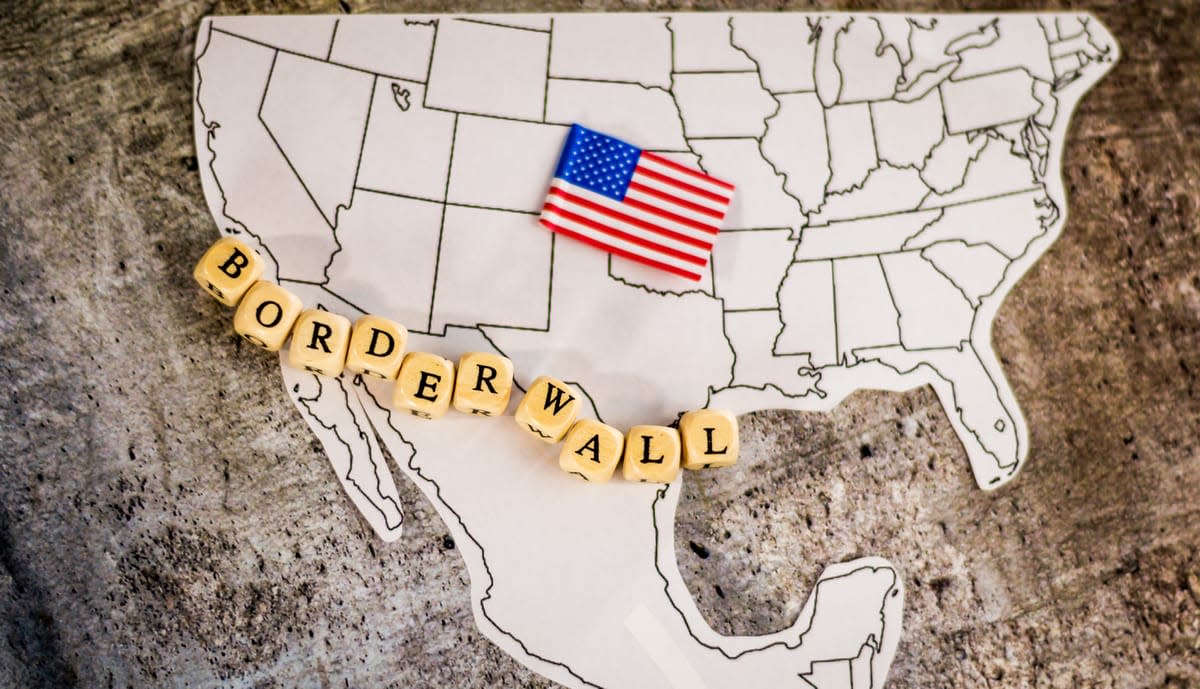
US President Donald Trump’s proposed wall on the US-Mexico border is more symbol than substance. There are better ways to combat contraband, illegal immigration and terrorism.
But what makes the idea of a physical barrier so symbolically potent? It’s partly that Trump has tied his political fortunes, ego and masculinity to the wall. It’s indelibly associated with Trump himself. Oppose Trump and you oppose the wall, and vice versa.
While partisanship is powerful, it’s neither the whole story nor the most interesting one. Cognitive science suggests that there’s something about a material barrier around a country that resonates in a way that more border agents, better document checks, and reducing demand for illegal drugs don’t. To understand that something, it helps to go back to the future.
This all seems familiar. Tensions with Russia are acute, but illegal immigration is also high on the US agenda. After a lucrative acting career, the oldest-ever president is elected as a hawkish, tax-cutting Republican. He’s not cognitively complex — rather than detailed policy analysis, he relies on gut instinct, a few simple, firm convictions and a cluster of political operatives.
These advisors prime the president with a simplistic proposal that becomes his signature issue: a physical barrier against an existential foreign threat. The barrier would be expensive, controversial and marginally effective at best. Determined adversaries could easily circumvent it.
The president’s allies prefer alternative policies and the barrier doesn’t poll particularly well among the public, either. But it proves popular with the president’s base and becomes the symbolic core of his agenda. The president refuses to abandon the idea — in fact, he uses national TV to promote it — and it becomes a serious sticking point in negotiations with domestic and foreign parties.
A sense of deja vu
If you feel like you’ve seen this movie before, you have. In a nationally televised address in March 1983, President Ronald Reagan proposed his Star Wars strategic missile defence program, aimed at replacing the doctrine of mutually-assured destruction with a nationwide, impermeable shield that would render incoming nuclear weapons “impotent and obsolete”.

As with all historical analogies, the comparison between Reagan’s missile shield and Trump’s border wall isn’t perfect. The key commonality is how their appeal derives from the deep system of metaphor that structures human understanding. Cognitive science shows how metaphors enable humans to grasp abstract concepts (knowing, for instance) in terms of familiar ideas (for example, seeing). Traces of these unconscious metaphors appear in idioms such as “I see what you mean”.
Metaphorical cognition is a universal, evolved human trait. So, it’s no surprise that metaphor is ubiquitous in politics and foreign policy. Experts and laypersons alike inhabit a metaphorical world in which countries are physical containers with insides, outsides, and bounding surfaces.
Security is often conceived of as protecting the national container from pressure and penetration by outside threats. Threats, too, are understood metaphorically. Migrants and narcotics become waves and floods that threaten to spill over borders. Nuclear warheads become raindrops that saturate or leak through defences.
By this logic, the best way to protect the container’s boundary is to seal it off and reinforce it with a physical barrier like a roof, umbrella, shield or wall. To the extent that the boundary is open or exposed, the nation is insecure.
These unconscious metaphors of security are key to understanding the symbolic power of Trump’s wall. “Build the wall” is a concise and compelling proposal. “Reduce demand for illegal immigration by providing development and governance assistance to Central America” is not. It’s awkward to chant at a rally, but more than that, it requires a series of counterintuitive mental leaps to appreciate. A wall, by contrast, just makes sense.
Reagan’s space shield was attractive for similar reasons. Critics claimed that Star Wars threatened the Soviets and that mutual deterrence was safer than building an anti-missile barrier. These arguments fell flat because they didn’t mesh with people’s tacit understanding of security.
Cold War nuclear strategy reversed the customary meanings of offence and defence. To appreciate how a shield could provoke an opponent, one had to consider the sequence of nuclear attacks, targeting cities versus military assets and more. The shield metaphor elided these complexities, concealing the fact that intercontinental ballistic missiles were, by the logic of nuclear strategy, defensive.
Star Wars opponents also had to convince Americans that safety lay in leaving their country open to attack. Citizens and policymakers both found the logic of mutually-assured destruction bizarre.
Not a done deal
So does the appealing metaphor embodied by Trump’s wall mean it will be built? Not necessarily. There’s a real world independent of our thinking, even if we can only grasp it through metaphor. Technological, political and economic realities ultimately killed Star Wars. Trump’s wall is vulnerable to the same fate.
But Reagan’s shield rhetoric turned strategic defence into a conservative litmus test. Republicans used it as a wedge issue throughout the 1990s, paving the way for the far more modest anti-missile system in place today. National missile defence is now the longest-running and second-most expensive military program in US history, and it remains as vulnerable as ever to technical failures and basic countermeasures. The Star Wars saga suggests that the wall will be with us for a long time. Never underestimate a good metaphor.





